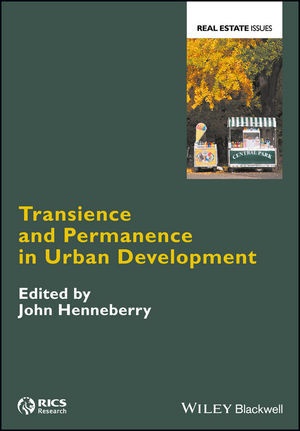Read more
Informationen zum Autor About the Editor John Henneberry is Professor of Property Development Studies at The University of Sheffield, UK, and a Chartered Planner and Chartered Surveyor. He has researched and published on property development and investment and their roles in urban and regional development for over 30 years. He is a Fellow of the Academy of Social Sciences, UK. Klappentext Temporary urban uses - innovative ways to transform cities or new means to old ends?The scale and variety of temporary - or meanwhile or interim - urban uses and spaces has grown rapidly in response to the dramatic increase in vacant and derelict land and buildings, particularly in post-industrial cities. To some, this indicates that a paradigm shift in city making is underway. To others, alternative urbanism is little more than a distraction that temporarily cloaks some of the negative outcomes of conventional urban development. However, rigorous, theoretically informed criticism of temporary uses has been limited. The book draws on international experience to address this shortcoming from the perspectives of the law, sociology, human geography, urban studies, planning and real estate.It considers how time - and the way that it is experienced - informs alternative perspectives on transience. It emphasises the importance, for analysis, of the structural position of a temporary use in an urban system in spatial, temporal and socio-cultural terms. It illustrates how this position is contingent upon circumstances. What may be deemed a helpful and acceptable use to established institutions in one context may be seen as a problematic, unacceptable use in another. What may be a challenging and fulfilling alternative use to its proponents may lose its allure if it becomes successful in conventional terms. Conceptualisations of temporary uses are, therefore, mutable and the use of fixed or insufficiently differentiated frames of reference within which to study them should be avoided. It then identifies the major challenges of transforming a temporary use into a long-term use. These include the demands of regulatory compliance, financial requirements, levels of expertise and so on. Finally, the potential impacts of policy on temporary uses, both inadvertent and intended, are considered.The first substantive, critical review of temporary urban uses, Transience and Permanence in Urban Development is essential reading for academics, policy makers, practitioners and students of cities worldwide. Zusammenfassung The first substantive, critical review of temporary urban uses, Transience and Permanence in Urban Development is essential reading for academics, policy makers, practitioners and students of cities worldwide. Inhaltsverzeichnis List of Contributors xiii Notes on Contributors xv Preface xxi Acknowledgements xxv 1 Introduction: Temporary Uses as Alternative Practices 1 John Henneberry Vacant land and temporary use 1 Theorising and conceptualising temporary use 3 Describing and analysing temporary uses 6 Critical analysis of temporary use 9 The coverage of the book 11 Acknowledgement 13 References 14 2 Forcing the Empties Back to Work? Ruinphobia and the Bluntness of Law and Policy 17 Luke Bennett Introduction: gazing upon the New Ruins 17 How ruinphobia unsettles us 18 Tracing ruinphobia into urban law and policy 20 Time is always running out for a building and its uses 26 Is ruinphobia forcing empties back to work, or are law's tools blunt? 27 References 28 3 Liminal Spaces and Theorising the Permanence of Transience 31 Nicola Livingstone and Peter Matthews Introduction 31 Theorising transient spatialities 33 Food banks as spaces of the in-between 36 Temporalities ...

